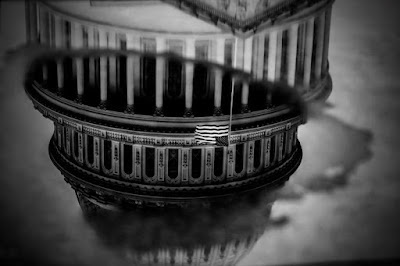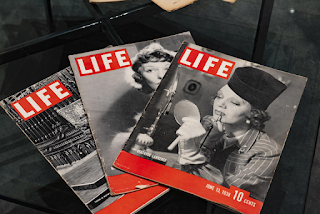November 1, 2025
Saturday, November 1, 2025
Inside NPPA’s fight for the future of photojournalism
Tuesday, July 22, 2025
CBS Evening News Feature On Stanley Forman's Pulitzer Prize-winning photo of a fatal fire escape collapse
July 22, 2025
How a photo of a deadly Boston fire sparked change
Sunday, January 12, 2025
Toledo Museum of Art in Ohio acquires two large-format prints by photographer Eugene Tapahe from his series "Art Heals: The Jingle Dress Project"
Santa Fe, NM - Monroe Gallery of Photography is pleased to announce that the Toledo Museum of Art in Ohio has recently acquired two large-format prints by photographer Eugene Tapahe from his series "Art Heals: The Jingle Dress Project." The prints are titled, “Solidarity, Sisterhood,” Monument Valley, Arizona, Diné, 2020, and “Four Worlds,” Grand Teton National Park, Wyoming, Cayuse, Umatilla, Newe Sogobia, and Tséstho'e, 2020.
Eugene Tapahe is a Diné (Navajo) contemporary artist and fine art photographer from Window Rock, Arizona, currently living in Provo, Utah. From an early age, Tapahe learned the significance of respecting, preserving, and protecting what is sacred—the land, water, and nature. He combines his passion for nature and culture with his educational background in graphic design, journalism, fine arts, and landscape and portrait photography to create stunning imagery. Tapahe fell in love with photography the moment he picked up a camera and discovered his unique talent for storytelling through his art. He has a deep desire to continue photographing the lands his ancestors once walked.
“Art Heals: The Jingle Dress Project” originated from Tapahe's dream during the COVID-19 pandemic, inspiring him to unite the land and people through the Ojibwe jingle dress dance in these uncertain times of sickness and social differences. Since then, Tapahe has traveled over 25,000 miles, documenting family members dancing the healing jingle dress dance in National Parks and Monuments, honoring the places where their ancestors once lived. This project has healed Tapahe’s family and ancestors and received national and international recognition for its unifying effect on other communities.
This month, “Kéyah: Our Home” by Eugene Tapahe will be exhibited at the BYU Museum of Art from January 24 to April 26, 2025. In the spring, selections from “Art Heals: The Jingle Dress Project” will be displayed by Monroe Gallery during The Photography Show presented by AIPAD at the Park Avenue Armory in New York City from April 23 to 27, 2025.
The Toledo Museum of Art was established in 1901 to share the transformative power of art with the community. Its 37-acre campus houses more than 30,000 artworks in architecturally significant buildings. Over the past several years, the museum has been working to expand its collection of Native American works of art, both historical and contemporary.
Monroe Gallery of Photography specializes in photography at the singular intersectionality of art and journalism.
Tuesday, August 6, 2024
Former police chief who launched a raid on a Kansas newspaper office and two homes is expected to be charged with obstruction of judicial process
August 5, 2024
By: Jessica McMaster
KANSAS CITY, Mo. — The former police chief who launched a raid on a Kansas newspaper office and two homes is expected to be charged with obstruction of judicial process, according to two special prosecutors who released their findings on the case Monday.
Saturday, July 20, 2024
"A long history of 'amazing photojournalism''"
July 19, 2024
Four photographers shot iconic images when gunfire rang out at Trump rally
"All of a sudden history is unfolding. You just have to keep making pictures"
"Their images will join others that captured some of the darkest days in U.S. history, such as the famous photo by Bill Eppridge showing a busboy helping Robert F. Kennedy moments after the presidential candidate was assassinated in 1968, and the images by Associated Press photographer Ron Edmonds of President Ronald Reagan being rushed to his motorcade after being shot in 1981."'
Bill Eppridge covered Robert F. Kennedy's 1968 Presidential campaign, see his work here.
Monday, March 18, 2024
Monroe Gallery Announces Representation of Mark Peterson
Monday, March 18, 2024
Santa Fe, NM - Monroe Gallery of Photography is
honored to announce exclusive representation of acclaimed photographer Mark
Peterson for fine art print sales.
Mark Peterson is a photographer
based in New York City. His work has been published in the New York Times
Magazine, New York Magazine, The New Yorker, Time, Fortune, National
Geographic, Geo Magazine and other national and international publications. In
2018 he was awarded the W. Eugene Smith grant for his work on White
Nationalism. His many awards include a first place Feature Picture Story in the
Pictures of the Year International Competition. Peterson’s work has been
featured in numerous exhibitions including his pictures of lowriders shown in
“Museums Are Worlds” at the Louvre in 2012.
He is the author of two books:
Acts Of Charity published by Powerhouse in 2004 and Political Theatre,
published by Steidl in the fall of 2016. His work is collected in several
museums including The National Gallery of Art in Washington DC and the Museum
Of Fine Arts, Houston. In 2024 Steidl will publish his book The Fourth Wall.
Although often not beautiful, or
easy, Peterson’s images shake and disquiet us; and once seen are etched in our
memories forever. “I like a lot of chaos
in my pictures. I do like to be close to the action. It gives me a feeling of
what is happening. I want to pull back the curtain and show these politicians
as they really are.”
Monroe Gallery will exhibit several examples
of Peterson’s work at the 2024 Photography Show presented by AIPAD in booth
#A52, April 25 – 28, 2024 at The Park Avenue Armory in New York City. On
Thursday, March 21st at 7pm Eastern, The Griffin Museum hosts Mark Peterson for
an on-line conversation about his creative path, his pull to politics and what
it takes to frame his vision as part of the museum’s current focus on power and
perception, democracy and how we see and envision our elected leaders.
Thursday, October 20, 2022
The magazine that gave photography unprecedented power
Via The Washington Post
October 20, 2022
This fact floored me: Between the Great Depression and the Vietnam War, according to the organizers of “Life Magazine and the Power of Photography,” an exhibition at Boston’s Museum of Fine Arts, “the majority of photographs printed and consumed in the United States appeared on the pages of illustrated magazines.”
Today, with photographs published and consumed everywhere, it’s staggering to think that their dissemination was ever so concentrated.
Preeminent among illustrated magazines was Life. Published as a weekly news magazine between 1936 and 1972, Life magazine sold in the tens of millions. When you include pass-along readership, its pages regularly reached about one-quarter of America’s population. -- click to continue with full article
Life Magazine and the Power of Photography Through Jan. 16 at the Museum of Fine Arts, Boston. mfa.org.
Related exhibit: The LIFE Photographers
Sunday, August 14, 2022
We need great photojournalism more than ever
August 14, 2022
OPINION: WE NEED GREAT PHOTOJOURNALISM MORE THAN EVER
Deputy Editor Geoff Harris reflects on the worrying trend of people simply shunning bad news – and what it could mean for photojournalism, documentary and news photography.
As somebody who believes passionately in the importance of hard-hitting documentary and news photography, I’m worried. A survey, recently shared by the BBC, reveals that a lot of people are turning off from the news as it makes them depressed.
According to the report, from the respected Reuters Institute, almost four in 10 of those surveyed say they often or sometimes avoid the news, a sizeable jump from 29% in 2017.
It also found the number of people avoiding news over the past five years has doubled in the UK (46%) and Brazil (54%).
Considering the devastation that the corrupt Bolsonaro regime is inflicting on the Amazon rainforests and indigenous tribes in Brazil, this is even more concerning, but I digress.
Photojournalism tells the truth about what is happening
When you think of some of the most influential news images in the history of photography – Dorothea Lange’s record of dirt-poor US migrants, or Nick Ut’s Napalm Girl photo – yes, they are upsetting and depressing.
This is not usually because photographers are trying to make viewers feel bad or have any kind of agenda (Ut certainly wasn’t against the anti-communist South Vietnamese forces who dropped the napalm), it’s because they want to tell the truth about what is happening around them. If more and more people are actively turning away from the news in order to ‘protect their mental health,’ where does that leave the next generation of photojournalists? Will they still be able to make a living?
Then there is the environment.
I’ve been lucky enough to interview a lot of great nature photographers over the years, including Frans Lanting and Joel Sartore, and most still believe that their photography can help protect endangered species or habitats through awareness-raising.
But what if an increasing number of potential viewers of these images just throw their hands up in the air and switch to cute puppy videos on YouTube or silly dance routines on TikTok?
Indeed, another recent report from OFCOM shows that TikTok is the fastest-growing news source for UK adults. Of course, not all content on TikTok is trivial, but it’s an illuminating and concerning trend.
Then there are the unhinged conspiracy theorists who accuse much mainstream news of being fake, following in the footsteps of cynical politicians like Donald Trump. Predictably, attacks on news journalists and photographers have risen exponentially.
We need great photojournalism more than ever
We need great photojournalism more than ever, as it’s one of the pillars of a free society, where politicians, big business and the military are held accountable. Shackling the press is one of the first things authoritarian regimes do – just ask any photojournalist struggling to tell the truth in China and Russia.
I also think that mental health charities and ‘experts’ should be doing more to dispel this insidious myth that the news is somehow damaging to people’s well-being. Certainly, today’s 24/7 news cycles mean it’s easy to feel overwhelmed, but we can all control how much news we consume, and only consume it from reputable sources. Sticking our head in the sands is no answer.
A few years ago, photojournalists were fretting that the biggest threat facing them was the closure of a lot of print-based media and the increasing use of freelancers and ‘citizen journalists’ by digital outlets. These threats remain, and jobs continue to be lost, but a general turning away from bad news is an even more worrying trend.
As photographers, we should be doing what we can to support and speak up for photojournalists, and of course, getting out there with our cameras ourselves. Stories of death and destruction are not new, but however much they seem to be piling up in 2022, it’s important we all face up to what is going on the world. How else are we going to help to change it?
Tuesday, October 5, 2021
‘It is becoming unbearable:’ Journalists say they have become ‘scapegoats’ at anti-vaccine protests
Via Committee to Protect Journalists
October 4, 2021
Journalists covering demonstrations against COVID-19 countermeasures have been called “terrorists,” “pedophiles,” “murderers,” and “scumbags.” Protesters have harassed and assaulted members of the press, and told them that “the nooses are ready.”
Threats like these have become increasingly familiar for reporters in Europe and the United States, where the U.S. Press Freedom Tracker, a CPJ partner, has recorded threats and assaults against reporters in cities including Los Angeles and Portland, Oregon.




